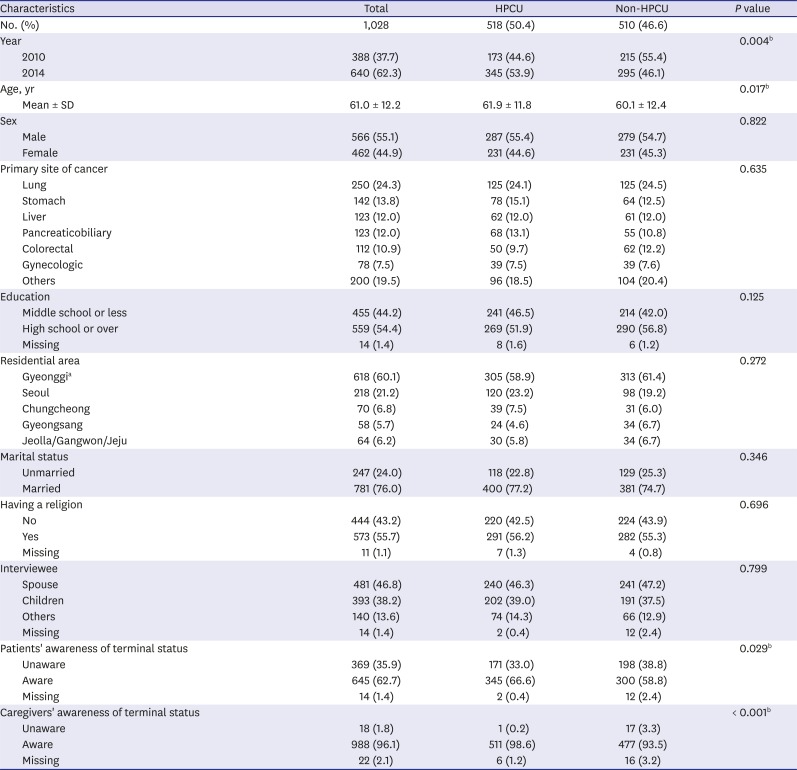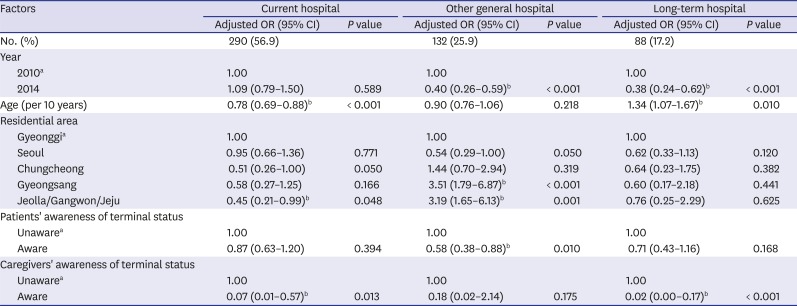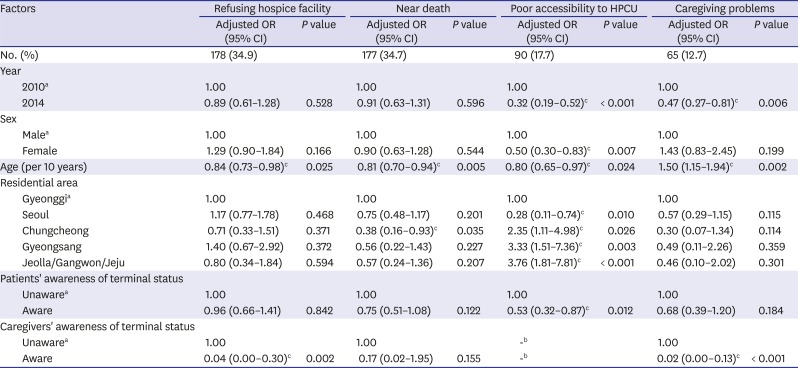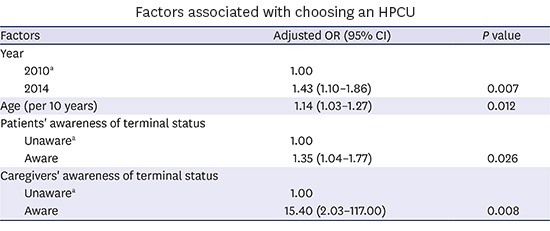1. World Health Organization. Global Atlas of Palliative Care at the End of Life. Geneva: World Health Organization;2014.
2. Centeno C, Lynch T, Garralda E, Carrasco JM, Guillen-Grima F, Clark D. Coverage and development of specialist palliative care services across the World Health Organization European Region (2005–2012): results from a European Association for Palliative Care Task Force survey of 53 Countries. Palliat Med. 2016; 30(4):351–362. PMID:
26231421.
3. National Hospice and Palliative Care Organization. NHPCO's Facts and Figures Hospice Care in America. Alexandria, VA: National Hospice and Palliative Care Organization;2015.
4. Economist Intelligence Unit. The Quality of Death Ranking End-of-life Care Across the World. London: Economist Intelligence Unit;2010.
5. National Cancer Center. Facts and Figures Hospice Care in Republic of Korea. Goyang: National Cancer Center;2016.
6. Teno JM, Shu JE, Casarett D, Spence C, Rhodes R, Connor S. Timing of referral to hospice and quality of care: length of stay and bereaved family members' perceptions of the timing of hospice referral. J Pain Symptom Manage. 2007; 34(2):120–125. PMID:
17583469.
7. Cheng WW, Willey J, Palmer JL, Zhang T, Bruera E. Interval between palliative care referral and death among patients treated at a comprehensive cancer center. J Palliat Med. 2005; 8(5):1025–1032. PMID:
16238515.
8. Hui D, Kim SH, Kwon JH, Tanco KC, Zhang T, Kang JH, et al. Access to palliative care among patients treated at a comprehensive cancer center. Oncologist. 2012; 17(12):1574–1580. PMID:
23220843.
9. Poulose JV, Do YK, Neo PS. Association between referral-to-death interval and location of death of patients referred to a hospital-based specialist palliative care service. J Pain Symptom Manage. 2013; 46(2):173–181. PMID:
23177723.
10. Good PD, Cavenagh J, Ravenscroft PJ. Survival after enrollment in an Australian palliative care program. J Pain Symptom Manage. 2004; 27(4):310–315. PMID:
15050658.
11. Jho HJ, Chang YJ, Song HY, Choi JY, Kim Y, Park EJ, et al. Perceived timeliness of referral to hospice palliative care among bereaved family members in Korea. Support Care Cancer. 2015; 23(9):2805–2811. PMID:
25739751.
12. Morita T, Akechi T, Ikenaga M, Kizawa Y, Kohara H, Mukaiyama T, et al. Late referrals to specialized palliative care service in Japan. J Clin Oncol. 2005; 23(12):2637–2644. PMID:
15728219.
13. McGorty EK, Bornstein BH. Barriers to physicians' decisions to discuss hospice: insights gained from the United States hospice model. J Eval Clin Pract. 2003; 9(3):363–372. PMID:
12895158.
14. Lee JR, Lee JK, Hwang SJ, Kim JE, Chung JI, Kim SY. Doctor's perception and referral barriers toward palliative care for advanced cancer patients. Korean J Hosp Palliat Care. 2012; 15(1):10–17.
15. Kang J, Koh SJ, Yoo YS, Choi YS, Choi JY, Chang YJ, et al. Development of the standard hospice and palliative care education program in Korea: results from the demonstration project. J Palliat Med. 2010; 13(6):703–710. PMID:
20597702.
16. Choi JY, Shin DW, Kang J, Baek YJ, Mo HN, Nam BH, et al. Variations in process and outcome in inpatient palliative care services in Korea. Support Care Cancer. 2012; 20(3):539–547. PMID:
21347522.
17. Yun YH, Heo DS, Jeon HY, Yoo TW, Kim YY, Huh BY. Behavior patterns of health care utilization in terminal cancer patients. J Korean Acad Fam Med. 1998; 19(6):445–451.
18. Paris J, Morrison RS. Evaluating the effects of inpatient palliative care consultations on subsequent hospice use and place of death in patients with advanced GI cancers. J Oncol Pract. 2014; 10(3):174–177. PMID:
24839276.
19. Morrison RS, Dietrich J, Ladwig S, Quill T, Sacco J, Tangeman J, et al. Palliative care consultation teams cut hospital costs for Medicaid beneficiaries. Health Aff (Millwood). 2011; 30(3):454–463. PMID:
21383364.
20. Tang ST, Liu TW, Shyu YI, Huang EW, Koong SL, Hsiao SC. Impact of age on end-of-life care for adult Taiwanese cancer decedents, 2001–2006. Palliat Med. 2012; 26(1):80–88. PMID:
21606128.
21. Chung RY, Wong EL, Kiang N, Chau PY, Lau JY, Wong SY, et al. Knowledge, attitudes, and preferences of advance decisions, end-of-life care, and place of care and death in Hong Kong. A population-based telephone survey of 1067 adults. J Am Med Dir Assoc. 2017; 18(4):367.e19–367.e27.
22. Burt J, Raine R. The effect of age on referral to and use of specialist palliative care services in adult cancer patients: a systematic review. Age Ageing. 2006; 35(5):469–476. PMID:
16751635.
23. Surbone A, Kagawa-Singer M, Terret C, Baider L. The illness trajectory of elderly cancer patients across cultures: SIOG position paper. Ann Oncol. 2007; 18(4):633–638. PMID:
17028242.
24. Chang YJ, Kwon YC, Lee WJ, Do YR, Seok LK, Kim HT, et al. Burdens, needs and satisfaction of terminal cancer patients and their caregivers. Asian Pac J Cancer Prev. 2013; 14(1):209–216. PMID:
23534725.
25. Block LV, Albers G, Pereira SM, Onwuteaka-Philipsen B, Pasman R, Deliens L. Palliative Care for Older People: a Public Health Perspective. Oxford: Oxford University Press;2015.
26. Yun YH, Lee MK, Kim SY, Lee WJ, Jung KH, Do YR, et al. Impact of awareness of terminal illness and use of palliative care or intensive care unit on the survival of terminally ill patients with cancer: prospective cohort study. J Clin Oncol. 2011; 29(18):2474–2480. PMID:
21576638.
27. Morita T, Akechi T, Ikenaga M, Kizawa Y, Kohara H, Mukaiyama T, et al. Communication about the ending of anticancer treatment and transition to palliative care. Ann Oncol. 2004; 15(10):1551–1557. PMID:
15367417.
28. Fink RM. Review of a study on late referral to a palliative care consultation service: length of stay and in-hospital mortality outcomes. J Adv Pract Oncol. 2015; 6(6):597–601. PMID:
27648349.
29. Humphreys J, Harman S. Late referral to palliative care consultation service: length of stay and in-hospital mortality outcomes. J Community Support Oncol. 2014; 12(4):129–136. PMID:
24971422.
30. O'Mahony S, McHenry J, Snow D, Cassin C, Schumacher D, Selwyn PA. A review of barriers to utilization of the medicare hospice benefits in urban populations and strategies for enhanced access. J Urban Health. 2008; 85(2):281–290. PMID:
18240022.








 PDF
PDF Citation
Citation Print
Print





 XML Download
XML Download